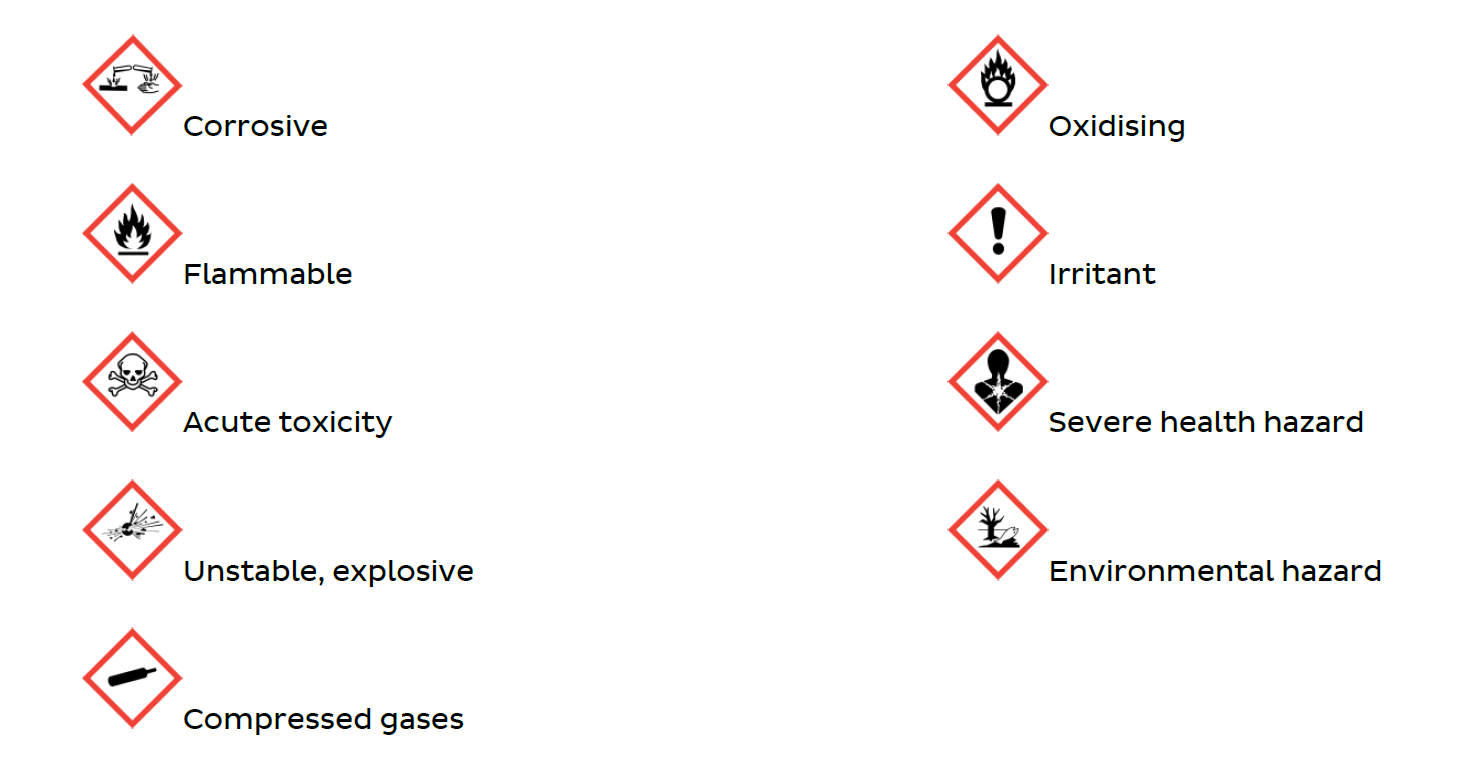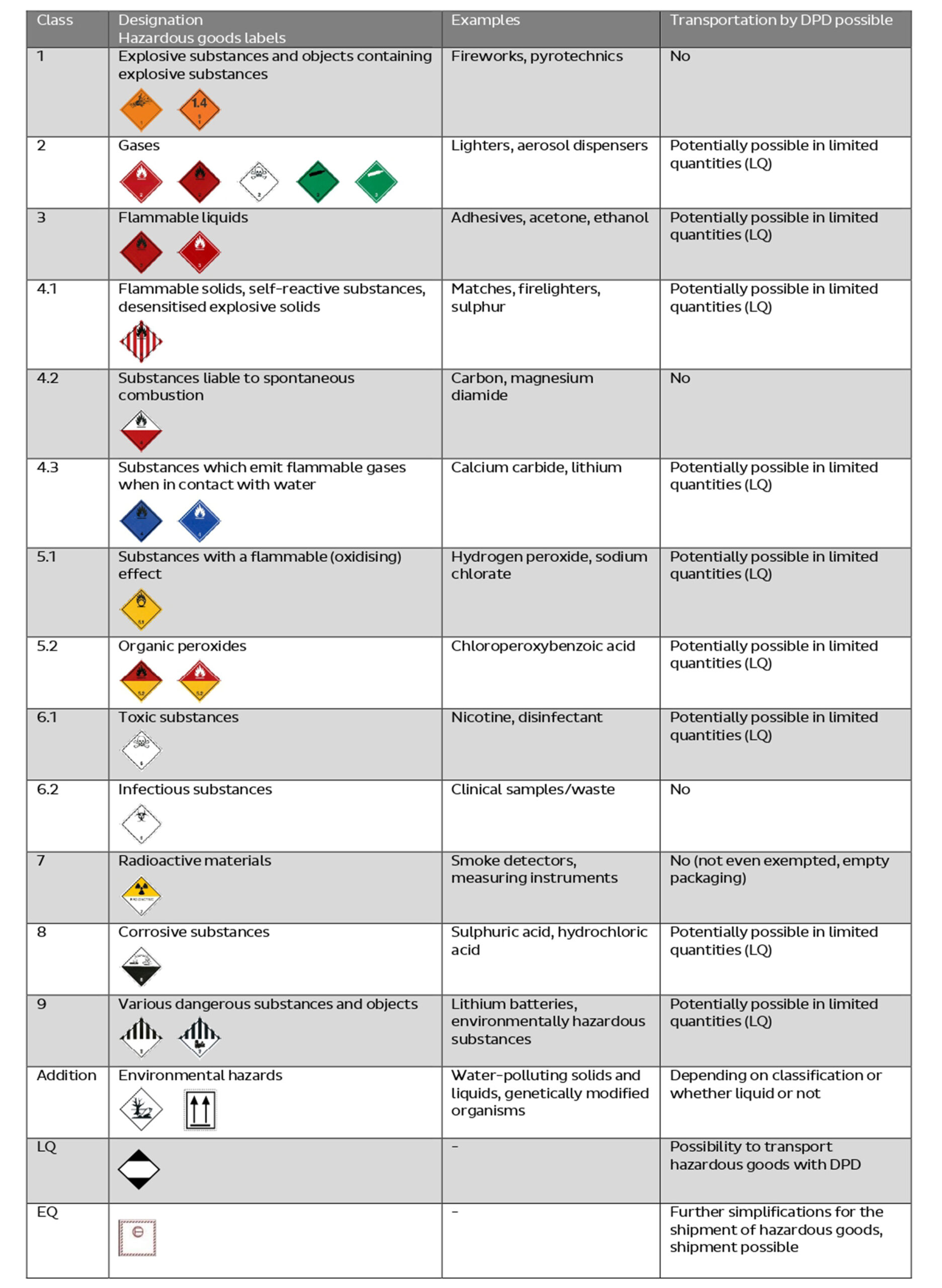What does ‘dangerous goods’ mean?
Substances and objects which, due to their nature, properties or condition, may, in connection with their transportation, pose a threat to public safety or order, in particular to the general public, to important public goods, to the life and health of persons, animals or property.
What is the difference between dangerous goods and hazardous materials?
Hazardous materials are materials that are stored or used. In contrast, dangerous goods are goods that are transported from A to B outside of a building. In principle, hazardous materials (the ones that may be transported) become dangerous goods when they are transported.
Examples of hazardous materials (GHS – globally harmonised system):
GHS applies only to the use and storage of these materials, which are therefore NOT YET dangerous goods.

Examples of dangerous goods and meanings of the symbols by dangerous goods class:

Interview with Rolf Neeracher:
Our line haul manager is a qualified dangerous goods safety adviser and is himself authorised to transport dangerous goods. As a dangerous goods safety adviser, he is personally responsible for training employees to handle and dispose of dangerous goods properly. He is also responsible for judging whether or not something can be delivered by DPD.
Beri: ‘Hi Rolf! Can you briefly describe what dangerous goods are in your own words?’
Rolf: ‘Hi Beri! Dangerous goods are liquids and articles which range from hazardous to deadly for society and the environment (flora and fauna).’
Beri: ‘What is the UN number for dangerous goods?’
Rolf: ‘All hazardous substances and dangerous goods have their own UN number. The UN number is a four-digit number that identifies materials or articles with similar properties for the purposes of transporting dangerous goods. The number is a unique identifier of the material or article and provides important information about the hazards. The UN number sometimes appears right on the packaging label. To be on the safe side, it is best to check the safety data sheet.’

Beri: ‘What does ADR actually mean?’
Rolf: ‘ADR has been around since 1957, and since 2021 it has stood for “Agreement concerning the International Carriage of Dangerous Goods by Road”. As the name suggests, it is an international treaty on the carriage of dangerous goods by road, and 54 states are currently party to it. It sets out a variety of rules. In Switzerland, ADR is implemented on Swiss roads by SDR, which is the Ordinance on the Carriage of Dangerous Goods by Road. ADR/SDR only applies to carriage by road, however; other modes of transport (planes, ships and trains) have their own rules and regulations.
Beri: ‘Why can we only transport limited quantities of dangerous goods?
Rolf: ‘To transport dangerous goods in larger quantities, you need separate equipment as well as special training and vehicle insurance, which we do not have. Those who are authorised to transport dangerous goods are also required to hand over a transport document with every delivery, which is not the case for us.’
Beri: ‘Why can we not even transport limited quantities of certain dangerous goods?’
Rolf: ‘We have to make two distinctions here. Some substances are not approved for carriage in limited quantities. For example, these include individual cosmetic products, fireworks and lithium batteries exceeding a certain capacity. There are also materials which, although we are permitted to transport them under ADR rules, are excluded in our GTC on the basis of their perceived risk. These include infectious substances, flooded batteries and lighters.’
Dangerous goods in limited quantities (LQ)
For nation-wide delivery:
Within Switzerland, DPD Switzerland transports a wide range of goods classified as dangerous in line with the relevant directive (ADR), which are packed in a limited quantity according to regulations. The following conditions have to be met:
-
Maximum 5 l / 5.0 kg of dangerous goods per inner package, depending on the UN number
-
The maximum gross weight of the package is 30.0 kg
-
Always composite packaging (inner packaging within outer packaging)
-
Inner packaging can be bottles, containers, canisters etc.
-
The outer packaging does not have to be tested according to UN, but it must meet the requirements of our General Terms and Conditions with regard to drop height and sorting capability
-
An LQ label must be attached to the outside of the packaging
-
Orientation arrows are mandatory for liquids
-
Sender information regarding the LQ conveyed to DPD (obligation to inform)
For international delivery:
Important! It is not possible to send DPD CLASSIC INTERNATIONAL parcels as limited quantities (LQ) to all countries. Below is a list of all countries (outside Switzerland) to which we can send LQ parcels (last updated January 2021):
-
Belgium
-
Denmark
-
Germany
-
France
-
Croatia
-
Latvia
-
Liechtenstein
-
Luxembourg
-
Monaco
-
Netherlands
-
Austria
-
Poland
-
Portugal
-
Slovenia
-
Spain
NB: This list changes constantly (ADR is updated every two years and/or the regulations in the various countries might change).
As transportation of dangerous goods is subject to strict legal conditions, we clarify all required processes with you in advance. Please contact your customer adviser with your enquiry, providing full classification (UN no., substance name, dangerous-goods class, packaging group I / II / III and classification code, if applicable).
Beri: ‘What happens if DPD discovers a prohibited item?’
Rolf: ‘Firstly, the parcel is halted wherever it might be. The relevant sales staff are then notified. They contact the consignees or shippers and let them know that they can collect the parcel from us. If it is not collected, it is disposed of at the expense of the shippers.’
Beri: ‘How are parcels which are defective or not collected disposed of?’
Rolf: ‘Using the safety data sheet, I look for and hire a specialist waste disposal company. The safety data sheet contains important information about labelling, hazards, handling, storage, transport, disposal and safe working conditions for a specific substance or mixture. For more details, see here.’
Beri: ‘Have we ever failed to notice that we were transporting dangerous goods?’
Rolf: ‘Hidden dangerous goods and prohibited dangerous goods are a serious and sadly recurring problem in the parcel delivery sector. Usually unknowingly but in some cases deliberately, people are put at risk of serious injury because, through ignorance or a desire to save money, parcels are not labelled or the shipper simply does not check whether they are even allowed to send their goods in a parcel. The sender is duty-bound to carry out these checks and failure to do so can lead to heavy fines.
Beri: ‘Do you have anything else you would like to add?’
Rolf: ‘The topic of dangerous goods is a highly complicated one. It seems important to me that the regulations concerning dangerous goods apply to private individuals as well as in the workplace, yet very few people actually take them into consideration. It is not normally a problem for someone to transport their personal shopping home, for example, even if it includes corrosive drain cleaner or disinfectants. It would become a problem, for example, if you were to transport a large tank of diesel to run an emergency generator at a junior football festival or several bottles of propane for a barbecue at the festival, or if you wanted to go on a journey with multiple battery-operated devices such as e-bikes. However, sources with detailed information about all this are available online.
Thank you, Rolf!


